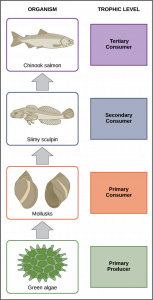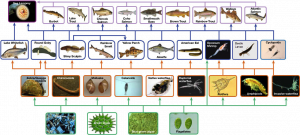Food Chains-DRAFT ONLY
Learning Objectives
Understand the role of producers, primary consumers, secondary consumers, tertiary consumers and decomposers in the food chain.
Learn about the food web and its complexity.
You’ve already learned about microbes; bacteria, viruses, protists, and fungi. These organisms make up what we are going to learn about today THE FOOD CHAIN.
The food chain is a linear sequence of organisms through which nutrients and energy pass as one organism eats another. Humans are a part of the food chain. Take a hamburger for example. Grass fed the cow which fed the human. This food chain would look like grass → cow → human. Obviously there is more involved in the hamburger sandwich, take the tomato for example. That would go tomato → human. Sometimes the food chain is not linear. This is when a food web is useful. First, let’s dig a little deeper into the natural food chain.
Starting at the bottom, are the producers. The producers are autotrophs, which means they make their own food. The autotrophs are the foundation of every ecosystem on the planet since they capture light and chemical substances that sustain all the other organisms in the entire community. There are two types of autotrophs: photoautotrophs and chemoautotroph. Photoautotrophs, such as plants, algae, and cyanobacteria, use energy from sunlight to make organic compounds through photosynthesis. Chemoautotrophs use energy from chemicals to build organic compounds through chemosynthesis. For instance, take this hydrogen sulfide-oxidizing chemoautotrophic bacteria which is found in undersea vent communities where no light can reach.
Next in the food chain are the primary consumers. The primary consumers eat the plants and other organisms that are producers. Usually the primary consumers are herbivores, which means plant eaters, though they may be algae or bacteria eaters. Our friends, the cows, sheep, and zebras are herbivores.
Next up, the secondary consumers. These are the meat-eaters, or the carnivores. The shark, lion, fox, and wolf are some of our secondary consumer friends.
Then there are the tertiary consumers, which eat the secondary consumers (Figure 1). These carnivores eat the carnivores. Our big fishy friends, and American’s bird the eagle are examples of these tertiary consumers.

Finally, we have the decomposers. The role of the decomposer is to break down dead organic material and wastes. They eat away at all the levels, whether it be a decaying plant producer, the body of a half-eaten squirrel, or the carcass of an eagle. Bacteria and fungi are the key decomposers in many ecosystems. Other decomposers, called detritivores, feed on dead organic matter and fragments making it easier for the bacteria and fungi to decompose as well. The decomposers play a key in the food chain since they release nutrients that can be recycled and used by the primary producers when they break down dead materials and waste.
As mentioned, most of the food chain is not represented using one linear perspective. Food chains help us see who eats who, but most ecosystems are pretty complex (Figure 3). A food web shows all the trophic, which means eating-related, interactions between species in an ecosystem. This food web is from Lake Ontario. Producers are marked in green, primary consumers in orange, secondary consumers in blue, and tertiary consumers in purple.

Next you will learn about how energy flows through this chain in the energy pyramid. Until then, stay hungry, stay free.

